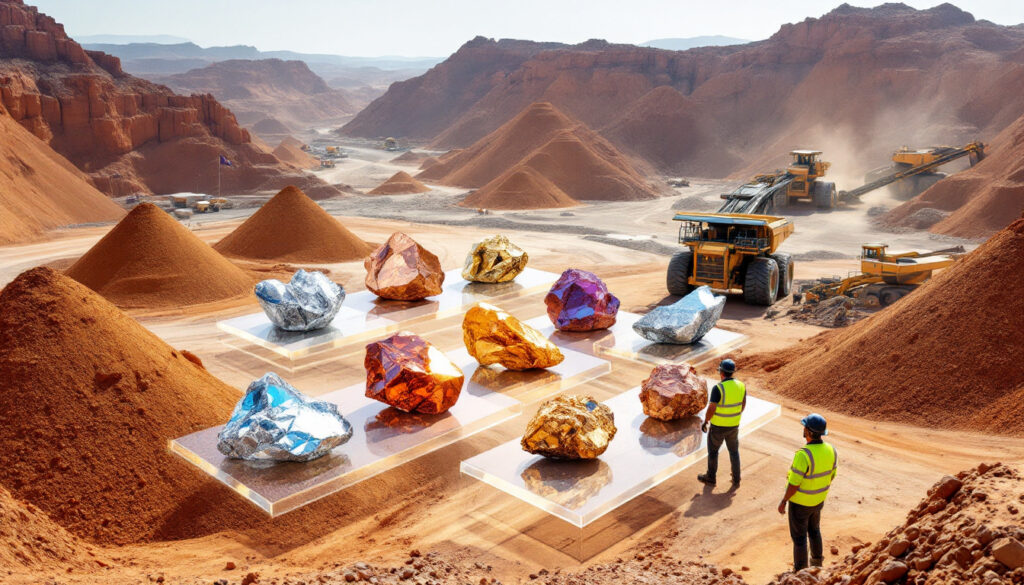What Are Critical Minerals in Old Mine Sites? NSW's Innovative Recycling Strategy
Mining waste is getting a second look in New South Wales as researchers uncover a treasure trove of critical minerals hiding in plain sight. The Geological Survey of New South Wales has launched the groundbreaking Mine Reuse Project that examines waste from both historical and operational mines to identify previously overlooked resources essential for our technological future.
After collecting and analyzing over 1,200 samples from 13 mining locations across the state, researchers have discovered elevated concentrations of 11 critical minerals including copper, cobalt, silver, and antimony. These discoveries represent not just an environmental win, but a significant economic opportunity for regional communities.
"There is a significant multiplier effect in the provision of this data, and it helps drive exploration and innovation," explained Phil Blevin, Chief Geoscientist and Head of the Geological Survey of NSW.
The extensive sampling program utilized high-precision chemical analysis to detect even trace amounts of valuable minerals in materials previously discarded as waste. This innovative approach redefines what constitutes "waste" in the mining sector and creates new possibilities for resource recovery.
Mining Sites Under Investigation
The project targeted multiple mining locations spanning New South Wales' mineral-rich regions:
-
Historical mines: CSA in the Central West, Queen Bee, Great Cobar, Nymagee in the Far West, Endeavour Elura, Endeavour McKinnons in the Central West, and Hillgrove in the Northern Tablelands
-
Current operational mines: Peak Gold Mine and Tritton near Cobar, RASP and Southern Operations near Broken Hill, and Stratford in the Upper Hunter
This comprehensive approach ensures that both legacy mine waste and contemporary tailings are evaluated for their potential to contribute to the critical minerals supply chain.
Success Stories in Mine Waste Reprocessing
The project has already highlighted several successful examples of mineral recovery from mine waste across NSW:
-
At Mineral Hill Mine in the Central West, operators have successfully extracted gold from historical tailings that were previously considered depleted
-
The Ardlethan mine site in the Riverina has demonstrated effective tin recovery from legacy mine waste, showcasing how older mining operations can yield additional value decades after closure
These success stories illustrate the practical application of the Mine Reuse Project's findings and provide a roadmap for similar initiatives across the state.
Why Are Critical Minerals Important for NSW's Economic Future?
Critical minerals and high-tech metals form the building blocks of modern civilization, powering everything from smartphones to solar panels. As global demand surges for these resources, NSW's mining industry stands at a pivotal crossroads.
The minerals identified in the NSW mine waste—copper, cobalt, silver, antimony, and others—play crucial roles in technologies that will define our future. Copper and cobalt are essential components in electric vehicle batteries and charging infrastructure. Silver is indispensable for solar panel manufacturing. Antimony provides critical fire-retardant properties for energy storage systems.
"These critical minerals are vital for electric vehicles, solar technologies, defence, and aerospace applications," Phil Blevin noted, highlighting their strategic importance across multiple industries.
As the world transitions to renewable energy and advanced technologies, securing reliable supplies of these materials becomes increasingly urgent. NSW's proactive approach positions the state to become a significant contributor to global critical minerals energy transition supply chains.
Strategic Value of Critical Minerals
Beyond their technological applications, these minerals represent strategic assets in an increasingly competitive global economy:
-
Energy transition enablers: They provide essential components for batteries, solar panels, wind turbines, and energy efficiency technologies
-
Defense applications: Many critical minerals are vital for aerospace, communications, and military technologies
-
Medical innovation: Advanced medical devices and diagnostic equipment rely on specific critical minerals
-
Digital infrastructure: Semiconductors, data centers, and telecommunications networks require these specialized materials
By identifying these resources within existing mining operations, NSW gains a competitive advantage in supplying these essential materials with lower environmental impact than traditional mining.
Economic Benefits for Regional Communities
The discovery of critical minerals in mine waste presents significant opportunities for regional communities that have historically depended on mining:
-
Job creation and retention: As mines near depletion of primary resources, critical mineral recovery can extend operational lifespans, preserving jobs and creating new specialized positions
-
Skill development: Processing complex waste materials requires advanced technical expertise, creating opportunities for workforce upskilling
-
Supply chain investment: Recovery operations attract investment in processing facilities, transportation infrastructure, and associated services
-
Regional economic diversification: Communities can leverage mining expertise into related technology and manufacturing sectors
This economic renewal could breathe new life into regional mining communities, creating sustainable economic activity for decades to come.
What Government Initiatives Support Critical Minerals Development?
The NSW government has implemented a comprehensive support framework to foster critical minerals development, recognizing both the economic and strategic importance of these resources.
NSW Critical Minerals and High-Tech Metals Strategy 2024-35
Central to the government's approach is the NSW Critical Minerals and High-Tech Metals Strategy 2024-35, which provides a long-term roadmap for developing this crucial sector. The strategy includes:
-
Systematic release of pre-competitive geological data to minimize investment risk for exploration companies
-
Coordination of research and development initiatives across government, industry, and academic institutions
-
Development of specialized processing capabilities for complex minerals
-
Streamlined regulatory pathways for critical minerals projects
-
Support for workforce development and specialized training programs
This strategic framework creates certainty for investors and operators, establishing NSW as a forward-thinking jurisdiction for critical minerals development.
Financial Support Programs
Complementing the strategic framework, the NSW government has implemented targeted financial incentives to accelerate critical minerals exploration and development:
-
$2.5 million co-investment fund specifically designed to support critical minerals explorers in their early-stage activities
-
$250 million royalty deferral initiative allowing new critical mineral projects to postpone royalty payments during their establishment phase, improving project economics
-
Ongoing investment in the Geological Survey of NSW to provide high-quality data that reduces exploration costs and risks
Courtney Houssos, NSW Minister for Natural Resources, emphasized: "This pre-competitive data helps minimise investment risk in exploration and identify new opportunities."
These financial mechanisms address key barriers to critical minerals development, particularly for smaller operators and junior mining companies that might otherwise struggle to secure capital for these specialized projects.
How Does Data Collection Drive Mining Innovation?
Behind every successful mining operation lies a foundation of geological knowledge. The Mine Reuse Project exemplifies how strategic data collection and analysis can transform industry perspectives and create new economic opportunities.
The Multiplier Effect of Geological Data
Phil Blevin, Chief Geoscientist and Head of the Geological Survey of NSW, highlighted the catalytic effect of comprehensive geological data: "There is a significant multiplier effect in the provision of this data, and it helps drive exploration and innovation."
This multiplier effect manifests in several ways:
-
Risk reduction: Detailed geological data significantly lowers the risk profile of exploration investments
-
Targeted operations: Companies can focus resources on the most promising areas rather than conducting broad exploratory work
-
Innovation stimulus: Awareness of potential mineral resources drives investment in new processing technologies
-
Collaborative potential: Shared data creates opportunities for partnerships between companies, researchers, and government agencies
-
Investment attraction: High-quality geological data makes NSW more attractive to international mining investors seeking data-rich jurisdictions
By providing this foundational information as a public good, the NSW government effectively accelerates the entire critical minerals sector.
Current Exploration Activity
The impact of the Geological Survey's work is already evident in exploration activity across NSW:
-
190 critical minerals exploration titles are currently active across the state
-
Companies are particularly focusing on regions highlighted in the Mine Reuse Project data, including Cobar, Broken Hill, and the Northern Tablelands
-
Additional data releases scheduled during NSW Minerals Week are expected to stimulate further exploration interest
This exploration activity represents the first step in a potential wave of critical minerals development that could transform NSW's mining sector and regional communities.
What Environmental Benefits Come From Mine Waste Reprocessing?
The environmental advantages of recovering critical minerals from mine waste represent a significant shift in mining's sustainability profile. Rather than viewing historical mining operations solely as environmental liabilities, this approach recognizes them as untapped resources.
Reducing Environmental Footprint
Reprocessing mine waste for critical minerals delivers multiple environmental benefits:
-
Waste reduction: Processing existing tailings and waste rock decreases the volume of stored mining waste management that requires long-term management
-
Land reclamation potential: As waste volumes decrease, opportunities for site remediation and rehabilitation increase
-
Water quality improvement: Removing minerals from tailings can reduce the potential for acid mine drainage and metal leaching
-
Energy efficiency: Recovering minerals from already-processed material typically requires less energy than extracting them from virgin ore
-
Carbon footprint reduction: Lower energy requirements translate directly to reduced greenhouse gas emissions compared to conventional mining
These environmental advantages align with increasing regulatory pressure and consumer demand for responsibly sourced materials with minimized ecological impact.
Circular Economy Applications
The Mine Reuse Project exemplifies circular economy principles by transforming what was once considered a liability into a valuable resource:
"This project represents a perfect application of circular economy principles—extracting additional value from materials previously considered waste while simultaneously reducing environmental impact." — Phil Blevin, Chief Geoscientist
This circular approach delivers several benefits:
-
Resource efficiency: Maximizing mineral recovery from already-extracted materials reduces overall resource consumption
-
Waste valorization: Converting waste streams into valuable products creates economic incentives for environmental remediation
-
Extended resource life cycles: Secondary recovery extends the productive use of minerals already brought to the surface
-
Reduced primary extraction pressure: Each ton of minerals recovered from waste potentially offsets a ton that would otherwise require new mining
This alignment with circular economy principles positions NSW's mining sector at the forefront of mine reclamation innovation and sustainable resource management.
How Do Critical Minerals Support the Clean Energy Transition?
The critical minerals identified in NSW's mine waste play indispensable roles in enabling the global transition to clean energy technologies. Without these specialized materials, many renewable energy systems and low-carbon technologies would be impossible to produce at scale.
Essential Components for Renewable Technologies
Each mineral serves specific functions in clean energy applications:
-
Copper: Essential for all electrical systems, with electric vehicles requiring 2-4 times more copper than conventional vehicles
-
Cobalt: Stabilizes lithium-ion battery cathodes, improving safety and extending battery life
-
Silver: Crucial conductor in solar photovoltaic cells, with each panel containing approximately 20 grams
-
Antimony: Provides critical fire-retardant properties in energy storage systems
-
Rare earth elements: Form powerful permanent magnets essential for wind turbine generators and electric vehicle motors
These applications directly support NSW's and Australia's renewable energy targets while creating economic opportunities in emerging industries. Furthermore, the copper demand surges as the electrification of transportation and renewable energy expansion continue globally.
Supply Chain Security
Domestic production of critical minerals from mine waste significantly enhances supply chain security:
-
Reduced import reliance: Australia currently imports many critical minerals despite having domestic resources
-
Manufacturing opportunities: Secure mineral supplies can attract downstream processing and manufacturing
-
Geopolitical stability: Domestic supply reduces vulnerability to international trade disruptions
-
Ethical sourcing: Australian-produced minerals meet high labour and environmental standards
-
National security: Many critical minerals have defense applications, making domestic supply strategically important
By developing these resources, NSW contributes to both national security and economic resilience in an increasingly uncertain global environment.
What's Next for NSW's Critical Minerals Sector?
The Mine Reuse Project represents just the beginning of NSW's critical minerals journey. With initial results demonstrating significant potential, both government and industry are positioning for expansion.
Upcoming Data Releases
The Geological Survey of NSW is preparing comprehensive data packages from the Mine Reuse Project for release during NSW Minerals Week. These releases will include:
-
Detailed chemical analyses of mine waste samples from all 13 studied locations
-
Maps identifying critical mineral concentrations across different historical mining regions
-
Technical recommendations for processing approaches best suited to different waste types
-
Economic assessments highlighting potential recovery values based on current market prices
-
Geological models predicting similar opportunities at unstudied sites with comparable characteristics
This data will be made freely available to encourage investment and exploration across the sector.
Future Research Directions
Building on the success of the Mine Reuse Project, several promising research directions are emerging:
-
Advanced processing technologies: Development of tailored extraction methods for complex mineral combinations found in historical tailings
-
In-situ recovery techniques: Research into methods to extract minerals with minimal disturbance to existing waste deposits
-
Carbon capture integration: Exploring how mine waste can simultaneously serve as carbon sequestration sites while yielding minerals
-
Environmental remediation technologies: Developing approaches that combine critical mineral recovery with site rehabilitation
-
Comprehensive mine waste mapping: Expanding the survey to include additional historical mining sites across NSW
These research directions will be pursued through collaborations between the Geological Survey, universities, CSIRO, and industry partners. Additionally, industry leaders are increasingly focused on mining sustainability transformation as a core business strategy.
FAQ: NSW Critical Minerals from Mine Waste
What are the 11 critical minerals identified in NSW mine waste?
The Geological Survey identified elevated concentrations of copper, cobalt, silver, antimony, and seven other critical minerals and high-tech metals essential for modern technologies. The complete list includes minerals crucial for renewable energy, electronics, and defense applications.
How does the $2.5 million co-investment fund work for explorers?
The fund provides matching investments to critical minerals exploration companies to offset initial exploration costs. Companies can apply for funding to support specific projects focused on critical minerals identification and development, with the government contribution matching private investment up to specified limits.
Why is NSW focusing on mine waste rather than new mine development?
Reprocessing mine waste offers numerous advantages including lower environmental impact, reduced capital requirements, faster time to production, and the opportunity to remediate historical mining sites while extracting valuable resources. This approach also faces fewer regulatory hurdles than new mine development.
How does the $250 million royalty deferral initiative benefit critical minerals projects?
This initiative allows new critical minerals projects to defer royalty payments during their establishment and early production phases. By improving early-stage cash flow, the deferral enhances project economics during the capital-intensive development period, making marginal projects more viable and accelerating project timelines.
What role does the Geological Survey of NSW play in critical minerals development?
The Geological Survey provides essential pre-competitive data that reduces exploration risk, identifies new opportunities, and supports innovation in the mining sector through comprehensive geological information and analysis. This government body conducts specialized sampling and analysis that would be prohibitively expensive for individual companies, effectively de-risking exploration investment.
Further Exploration
Readers interested in learning more about critical minerals development in New South Wales can explore additional resources from the NSW Minerals Council, the Geological Survey of NSW's online data portal, and the federal government's Critical Minerals Strategy. According to the Australian Government's critical minerals strategy, the country is positioning itself to become a global supplier of choice for these essential resources. Industry events during NSW Minerals Week also provide opportunities to engage directly with researchers and industry leaders advancing this innovative approach to resource development.
Ready to Capitalise on the Next Major Mineral Discovery?
Stay ahead of the market with real-time alerts on significant ASX mineral discoveries through Discovery Alert's proprietary Discovery IQ model, which instantly transforms complex mineral data into actionable investment insights. Discover why major mineral findings can generate substantial returns by exploring the historic examples on Discovery Alert's dedicated discoveries page.




